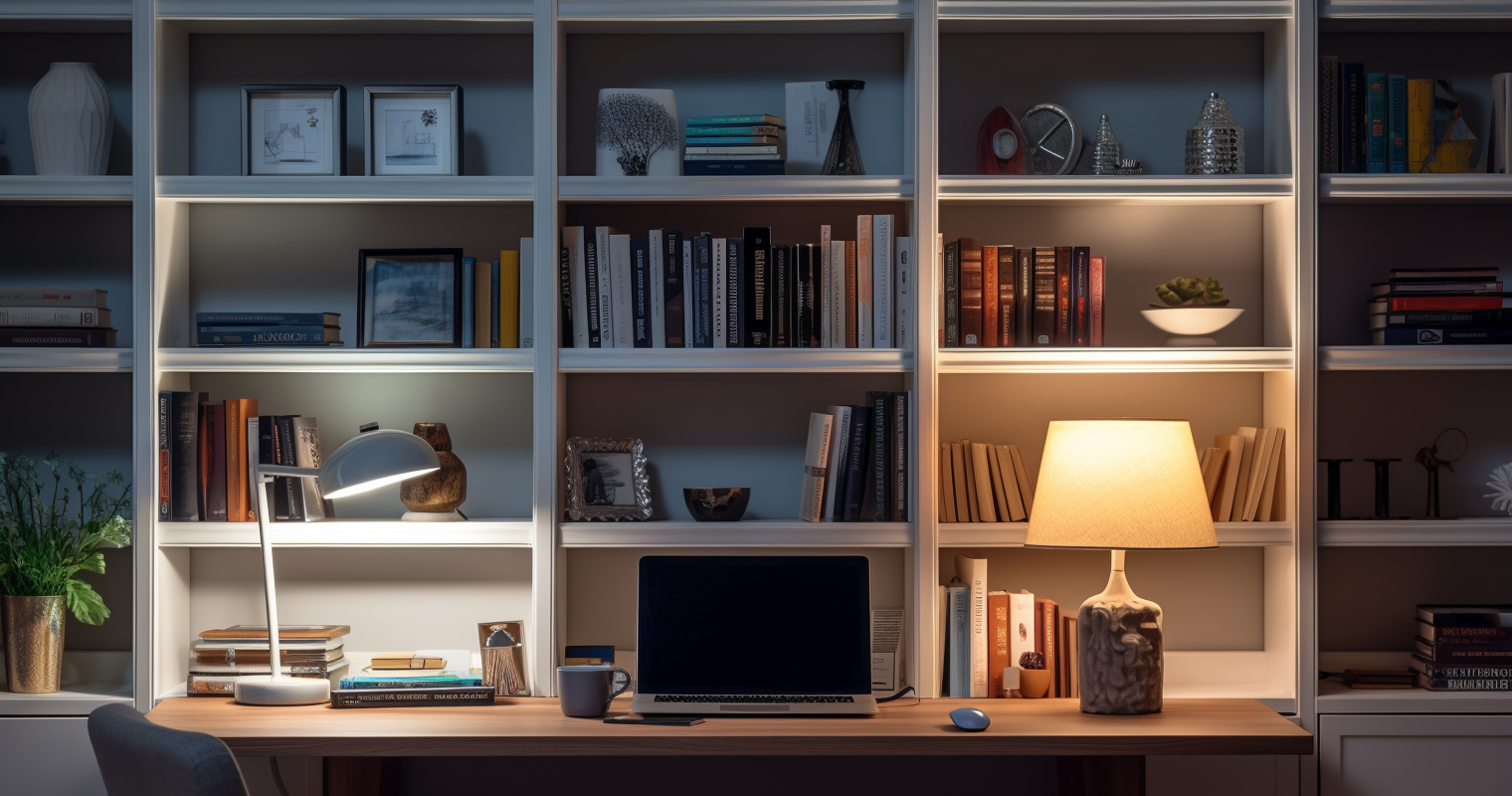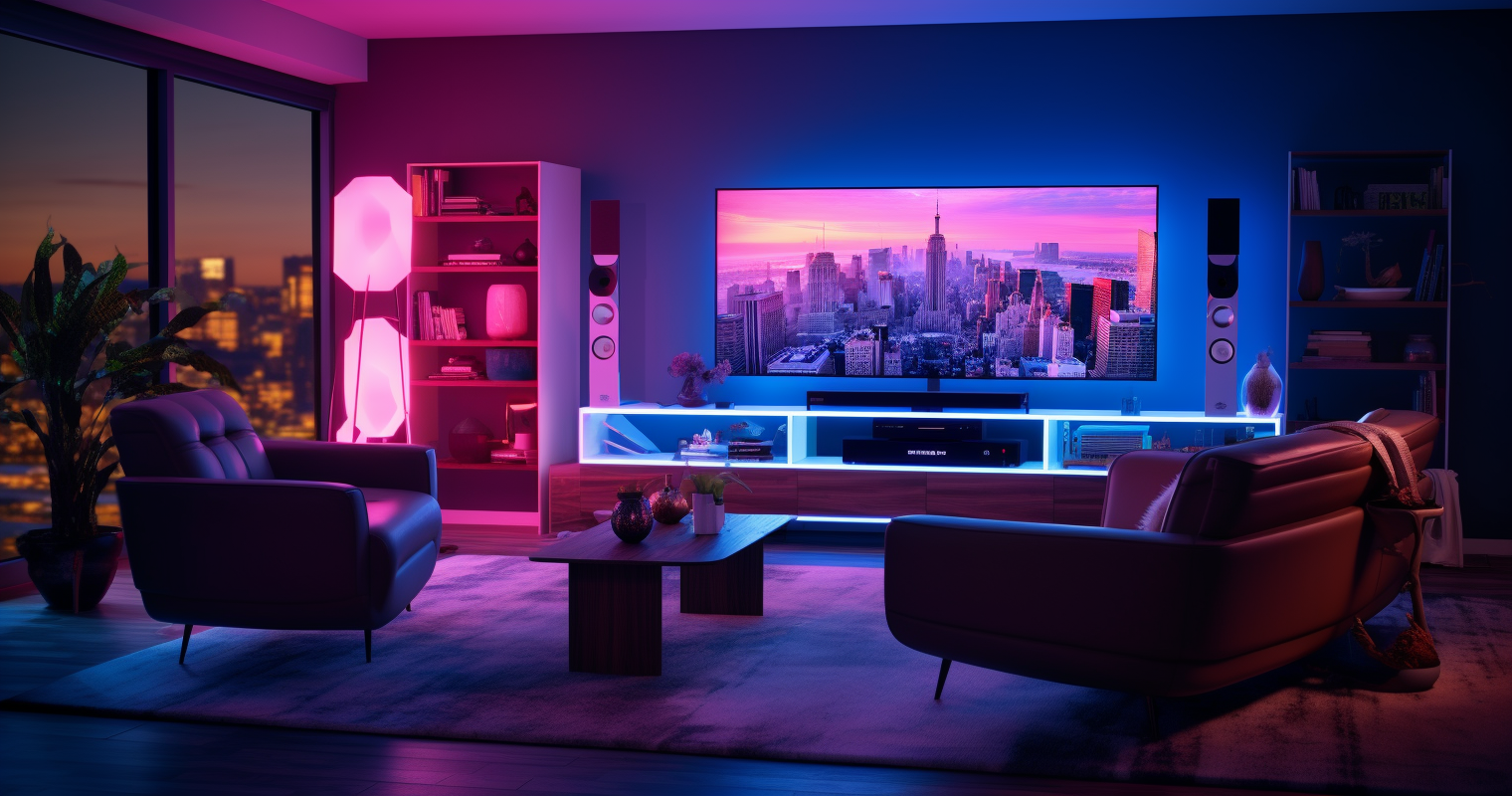Ever walked into a room and felt an inexplicable warmth or serenity wash over you? There’s a good chance that ambient lighting had a role to play. Illuminating design isn’t just about brightness; it’s about creating the perfect ambiance. In the realm of interior design, lighting can make or break a space. According to the Lighting Research Center, ambient lighting accounts for 50-75% of an interior’s total illumination.
Defining Ambient Lighting
When we hear the term “ambient,” many of us might think of soothing spa music or perhaps the soft murmur of a coffee shop. In the world of interior design, ambient is all about light. Ambient lighting refers to the general illumination that fills a room, making it possible to see and move around. It’s the comfortable glow you’d want in a living room or the background brightness in a workspace.
Task lighting, as the name implies, is designed for specific tasks. Reading, cooking, or any other activity that requires focused light falls under this category. On the other hand, accent lighting serves a more decorative purpose. Want to highlight a beautiful painting or a unique architectural feature? That’s where accent lights come into play.
However, ambient lighting’s main role is more profound. It sets the mood and atmosphere of a space. A well-lit room with balanced ambient light can make you feel warm, cozy, and right at home.
For more comprehensive insights on ambient lighting, do check out this detailed guide.
Historical Context of Ambient Lighting in Design
Delving into the annals of interior design, one finds that lighting wasn’t always the complex art it’s considered today. In ancient times, the primary source of light was, well, daylight. As night fell, the flickering glow of a candle or a lantern served as the precursor to our modern ambient lighting.
Fast forward a few centuries, and the design world witnessed the rise of ambient lighting as an essential element in contemporary settings. It became more than just about visibility; it played a pivotal role in the aesthetic and emotional resonance of a space.
What’s fascinating is the variation across cultures. For instance, the soft ambient lighting seen in traditional Japanese homes significantly contrasts with the vibrant hues preferred in some Mediterranean countries. Each culture, in its unique way, has harnessed ambient lighting to reflect its values, history, and artistic inclinations.
For a journey through the annals of lighting in design, don’t miss this illuminating read.
Types of Ambient Lighting Sources
Not all ambient light is created equal. Some prefer the golden rays of the sun streaming through a window – that’s natural ambient light for you. Its significance? Well, besides the Vitamin D boost, it brings out the authentic colors of your interiors and plays a vital role in regulating your body’s internal clock.
Then we have the realm of artificial sources. The grandeur of chandeliers dangling from a high ceiling, the subdued glow of wall-mounted lights, or the futuristic luminescence of LED strips – each adds a distinctive character to a space.
Chandeliers, with their intricate designs, often become the centerpiece of a room. Wall-mounted lights can highlight or soften wall textures, and LED strips bring versatility and modernity. However, each has its own set of pros and cons. While chandeliers can illuminate vast spaces, they might not be ideal for a minimalist setup. LED strips are energy-efficient, but they might not always provide the broad coverage needed in larger rooms.
For more insights on The Most Effective Led Light Strips Kits To Purchase, explore this insightful article.
Good ambient lighting can transform a room from mere bricks and mortar into a living, breathing entity. Whether you’re harnessing the natural light of the sun or deciding between LEDs and wall mounts, make it count. After all, in the words of Robert Alden, “There are two kinds of light – the glow that illumines, and the glare that obscures.”
What Is Ambient Lighting In Interior Design: Crafting the Perfect Ambience
Ever walked into a room and felt an instant sense of warmth and comfort, without really knowing why? You were likely enveloped in the soft embrace of ambient lighting. At its core, the question, “What Is Ambient Lighting In Interior Design,” revolves around creating a consistent, gentle illumination that ties a room together.
Ambient lighting, in the design world, is akin to the base coat of your favorite nail polish. It sets the stage. It ensures there aren’t any dark corners that might trip you up (literally and design-wise) and allows other design elements to shine.
In recent years, the design trends have shifted towards more integrated ambient lighting solutions. Think recessed ceiling lights or strategically placed floor lamps that not only light up space but also serve as statement pieces.
Balancing functionality with aesthetics is the key. Your living room might look straight out of a design magazine with those elegant pendant lights, but if they leave you squinting during your book club meetings, their design purpose is defeated.
For a deeper dive into the intricacies of interior lighting design, you can’t miss out on this comprehensive article.
Practical Tips for Implementing Ambient Lighting

We’ve all been there – swapping out bulbs, moving lamps around, all in the quest for that perfect, warm glow. But achieving the right ambient lighting doesn’t need to be trial and error.
Uniformity is the name of the game. Ensure lighting fixtures spread their glow evenly to foster a relaxed atmosphere. That being said, different rooms serve different functions. Your workspace might require brighter lighting compared to the dim, cozy ambiance you’d prefer in your bedroom.
Ever notice how certain lights make a room feel cold and others give off a warm vibe? That’s the color temperature at play. In technical terms, it’s measured in Kelvins, but all you really need to know is to opt for warmer hues in lounging areas and cooler, more invigorating tones in workspaces.
For a more hands-on guide to getting your ambient lighting just right, look no further than this expert advice.
Lighting Layering Techniques
Now, imagine ambient lighting as the bread in a lighting sandwich (yes, we’re talking design and sandwiches here). To add the fillings that make the sandwich truly delectable, you’ll need task and accent lights. Welcome to the world of lighting layering.
Lighting layering is, well, exactly what it sounds like. It’s the process of combining ambient, task, and accent lights in a space to serve varied purposes while maintaining a harmonious design. By layering these lights, you’re not just illuminating; you’re crafting experiences.
For instance, a study room might have soft ambient light complemented by a focused task light on the desk and a spotlight accentuating the library. All these layers come together to create a multifunctional space that caters to reading, working, and showcasing.
With the right ambient lighting, every room can tell a story. It’s not just about brightness, but the mood, the feeling, and the memories crafted within those four walls. As with all things design, it’s equal parts science and art. So, go on, light up your world!
Technological Advancements in Ambient Lighting

Technology has its fingers in many pies, and ambient lighting is no exception. Gone are the days of merely flipping a switch. Welcome to the era of smart lighting solutions that adapt to our moods, schedules, and even the movies we’re watching.
| Advancement | Description |
|---|---|
| LED Innovations | Energy-efficient LEDs offer versatile color options and are environmentally friendly. |
| Smart Lighting Systems | Interactive systems that adjust lighting based on mood, schedule, and activities, offer a personalized experience. |
| Color Temperature | LED technology allows users to select warmer or cooler light hues according to the desired ambiance. |
Firstly, let’s give a round of applause to LED innovations. Not only are they kinder to Mother Earth with their energy-efficient prowess, but they also offer a versatility that older bulbs could only dream of. From cool blues, for a productive workspace to warm yellows for a cozy reading nook, LEDs have it covered.
But wait, there’s more! Interactive and dynamic ambient lighting systems have entered the chat. Picture this: Lights that dance to your favorite tunes or adjust based on the movie genre. Sci-fi thriller? Stark white. Romantic comedy? Warm and rosy. Technology has made lighting more of an experience than a utility.
Curious about the interplay between ambient, task, and accent lighting in the modern tech era? Dive in here for a dose of light spiration.
Case Study: Transformation with Ambient Lighting

Nothing spells clarity like a good ol’ before-and-after comparison. Let’s take a virtual walkthrough of a space that underwent an ambient lighting transformation. The initial setting? Drab, uninviting, with shadows in all the wrong places.
Enter stage right: Ambient lighting solutions. Challenges included ensuring uniform illumination without creating a sterile environment. The strategy involved layering different light sources and using adjustable fixtures.
Post-transformation? The space went from ‘meh’ to ‘magnificent’. The occupants were in for a treat. The once gloomy living room was now an inviting space for both introspective moments and boisterous game nights. Feedback from the occupants was overwhelmingly positive, citing the space’s newfound warmth and versatility.
For a visual treat and deeper understanding, check out this transformation journey on YouTube.
The Future of Ambient Lighting in Design
Gazing into our crystal ball (or LED bulb), the future of ambient lighting seems bright and sustainable. As the world veers towards sustainable solutions, ambient lighting is hopping on that green bandwagon. Expect to see innovations that are not just energy-efficient, but also manufactured with a minimal carbon footprint.
Next on the horizon? Designs that seamlessly integrate with our daily lives. Think lights that sync with our biological clocks or adjust based on outdoor light conditions. The role of continuous research in this realm cannot be overstated.
With growing awareness about the planet’s health, sustainability, and green design considerations are at the forefront. As the interior design industry evolves, ambient lighting promises to be a blend of aesthetics, functionality, and responsibility.
Ambient lighting has come a long way from mere functionality. It’s about creating atmospheres, invoking emotions, and responsibly lighting up our future.
Frequently Asked Questions
What Is Ambient Lighting In Interior Design?
Ambient lighting, in the world of interior design, is the primary source of light in a room, responsible for its overall illumination and mood setting.
How does ambient lighting differ from other lighting types?
- Ambient Lighting: Provides general, overall illumination.
- Task Lighting: Focuses on specific areas, aiding in tasks like reading.
- Accent Lighting: Highlights or draws attention to specific objects or areas.
Why is ambient lighting crucial in interior spaces?
Ambient lighting sets the tone and mood, creating a foundational illumination that can be layered with other light types for depth and drama.
Can I rely solely on natural light for ambient lighting?
Natural light is fantastic but can be unpredictable. Combining it with artificial sources ensures consistent and adjustable illumination.
Are there any popular design trends involving ambient lighting?
Yes, trends like dimmable LED installations and smart lighting systems allow homeowners to customize ambiance with the tap of a button.
Conclusion
Ambient lighting, often overlooked, holds a pivotal role in shaping our spaces. Understanding What Is Ambient Lighting In Interior Design not only equips you with the knowledge to transform your home but also underscores the importance of lighting in the overall design. Looking to create a haven of comfort, warmth, or even drama? It’s time to play with light! Share your thoughts below, and let’s shine a light on the impeccable design together.
Thank you for reading!
